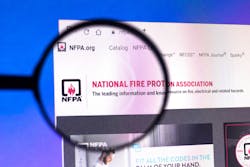The Most Important Changes to the 2021 NFPA 70E
The NFPA 70E, Standard for Electrical Safety in the Workplace is the gold standard for electrical workers when it comes to keeping them safe on the job site. Updated and revised every three years, the new version always supersedes all previous versions. On the final morning of NECA 2021, Michael Johnston, executive director of standards and safety for NECA, and Jim Dollard, safety coordinator for the Philadelphia Electrical JATC, presented on some of the most important changes to the 2021 edition of the standard and what those revisions mean for users.
To start, Johnston and Dollard discussed changes to NFPA 70E regarding definitions. “Definitions are critical,” said Dollard. He and Johnston described a few of the more significant ones, which include:
- A new sentence was added to Informational Note (IN) No. 1 on Arc Flash Hazards to assist users when determining if an arc flash exists.
- The definition of Available Fault Current has been modified with a new IN, which clarifies that available fault current varies at different locations within the system due to the location of sources and system impedances.
- A Barrier is now more clearly defined, with a revision added to clarify the difference between it and a Barricade.
- The definition of Switchgear, Arc-Resistant has been modified and broadened to Equipment Arc-Resistant.
- A new IN has been added to the definition of an Electrically Safe Work Condition (ESWC).
Next, they highlighted the general reorganization of requirements in Art. 110, which is meant to increase usability, clarity, and visibility for users of the standard. These relocations were considered a priority, Dollard and Johnston agreed. Some of the key relocations and modifications include:
Overall, both Johnston and Dollard reiterated the importance of each of these changes in creating electrically safe work conditions for all users. “We’re on the front line. We have to get this right,” said Johnston. “This is what the standard is all about.”
About the Author
Ellie Coggins Angus
Ellie Coggins Angus is the managing editor for EC&M and was formerly the associate editor for Electrical Wholesaling. She has more than five years of experience in the B2B publishing space covering the electrical contracting/wholesaling industry. Ellie received an MA in journalism from Syracuse University and a BA in English from University of Cincinnati. She is currently based in Cincinnati, Ohio. Connect with her at [email protected] or on LinkedIn.

